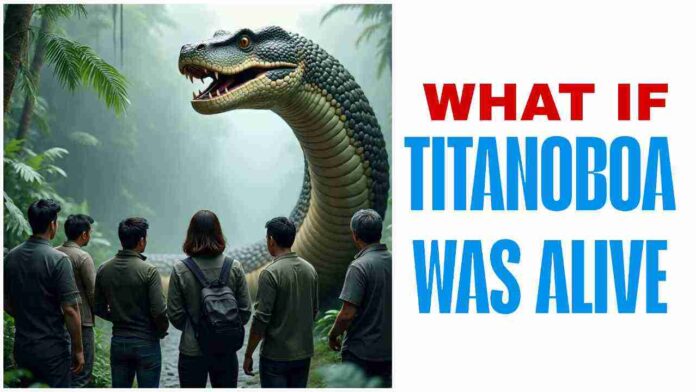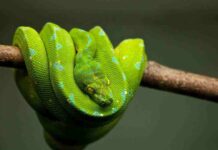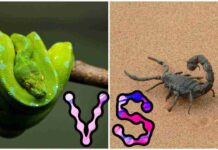What if Titanoboa was still alive? You may be hearing this name for the first time — Titanoboa was one of the largest species of snakes to ever roam the Earth. A long time ago, the largest snake species, called Titanoboa, ruled the planet. Because of climate change and environmental reasons, this large species went extinct, but we still have fossils that prove these enormous snakes once roamed forest areas.
Humans have a lot of questions about them and we always seek answers. If you are one of those who knows about Titanoboa, then you probably have many questions about this creature: How did it look back then? How large was Titanoboa? What did it eat? Many people wonder, “What if Titanoboa were still alive?”
To find answers to questions like these, we consult experts and scientists and consider their assumptions and predictions about what could happen if Titanoboa were still on Earth.
First, a brief introduction: I am Vishwajeet, and I have a master’s degree in zoology. I study living beings, and the assumptions and reasons given in this article are based on the reconstructed lifestyle of Titanoboa as suggested by scientists and available research papers. On the basis of that lifestyle, we have predicted a few things that could really happen if Titanoboa were still alive today.
Around 50 years ago, it was roaming around the Earth, and the size of this snake was massive. That’s why it is called the largest snake species that ever crawled on Earth. The size of this snake was larger than a school bus, and it was terrifying enough to instill fear in human beings. It was a terrific predator, and its looks alone were enough to spread terror among humans and other animals. Let’s now explore — what if Titanoboa was still alive?
What if Titanoboa was still alive?
S.N. | What if Titanoboa was alive |
|---|---|
1 | Adapted to the Environment |
2 | Divided into Subspecies |
3 | Endangered Species |
4 | Coexisting with Humans |
5 | Affected Human Development and Growth |
6 | Possible Domination |
1. Conflict between humans and Titanoboa
Many people think about this, and many scientists have still left this topic untouched. But in my assumption, this conflict could have been possible. Humans are not so foolish that they would do nothing to protect themselves from being eaten by the largest reptile. Humans are gifted with a good brain, and they could find any method to protect themselves from this reptile. Because of its massive size, even a small hit from Titanoboa could cause serious damage to a human being.
It is possible that these large predators and human beings, cursed or blessed with intelligence, could not live together peacefully. There are high chances that conflict between humans and this reptile would have been seen. Just like tigers, snakes, and many other species that were hunted for their skin, meat, and other products, it is also possible that humans, in order to protect themselves, may have started hunting these giant snakes.
Definitely, Titanoboa’s massive size would require a huge amount of food, and in the search for food, conflict with humans would have been predictable. There are high chances that either to protect themselves or for money, people may have killed this large species. Scientists, on the other hand, may have tried to capture and keep them in zoos so that the conflict between humans and Titanoboa could be prevented.
2. Adapted to the Environment
In the natural struggle for survival, not every living being can survive. Only the animals that follow the criteria of living on Earth could continue to exist. Numerous animals have gone extinct just because they could not adapt according to the environment. The environment of the Earth keeps changing, and not every living being can tolerate either very high or very low temperatures.
Titanoboa was known as a cold-blooded reptile, and it required a certain range of temperature to survive. In the upcoming centuries, as the temperature of the Earth kept changing, Titanoboa would have needed to adapt in order to survive. If it had adapted successfully, it is possible that Titanoboa could have developed warmer-blooded traits, unlike some reptiles and fishes. We might have seen multiple changes in its body structure.
We have already seen such adaptation in the evolution of giraffes. Long ago, giraffes were comparatively shorter, but in the search for food, they had to stretch their necks upward to eat leaves from tall trees. Over generations, their necks adapted and grew longer. Similarly, Titanoboa might have adapted its physiology according to Earth’s changing environment. If it failed to adapt, extinction was the only result. This is one of the greatest reasons Titanoboa is no longer on Earth.
3. Divided into Subspecies
We have seen many animals with multiple subspecies. For example, the cobra species has various subspecies depending on environment and habitat. Some are very large, while others are medium-sized. The same could have happened with Titanoboa.
Due to lack of food to sustain its massive size, it is possible Titanoboa might have decreased in size over generations. Environmental adaptation could also have led to the emergence of multiple subspecies of this giant snake.
4. Endangered Species
Because of certain environmental changes, Titanoboa might have become an endangered species. To protect them from extinction, scientists could have developed special environments to preserve these reptiles. This possibility is very high, considering the current difference in Earth’s climate compared to millions of years ago.
If a few Titanoboas had survived, they still might have been classified as endangered. Naturalists and scientists never want a species to go extinct, so they would have tried their best to protect Titanoboa, much like conservation efforts for endangered animals today.
5. Coexisting with Humans
It is not always necessary that humans and Titanoboa would have been in constant conflict. For example, in the Amazon rainforest, many large snake species live without human interference, and they also do not disturb humans.
It is possible that vast forest areas could have served as Titanoboa’s habitat. As long as humans respected their boundaries, both species could have coexisted on Earth. Accidental attacks might have occurred, but overall coexistence was possible.
Even today, large anaconda species survive in the Amazon without much human interruption. Who knows — perhaps anacondas are distant relatives or subspecies of Titanoboa?
6. Affected Human Development and Growth
If Titanoboa were still alive, it might have had some effect on human development and growth. The probability is rare, but not impossible.
If Titanoboa populations had survived and spread widely, they might have been one of the dominant creatures on Earth. This could have slowed down human progress, as much energy would have been spent protecting ourselves. Development and industrialization might have taken thousands of years longer compared to what we have achieved today.
However, the chances that Titanoboa could wipe out humans are very low. Humans have intelligence and survival instincts, and they could have found ways to protect themselves. Still, their presence might have slowed technology, civilization, and growth. Eventually, industrialization could have negatively impacted Titanoboa’s population, leading to its decline or permanent extinction.







